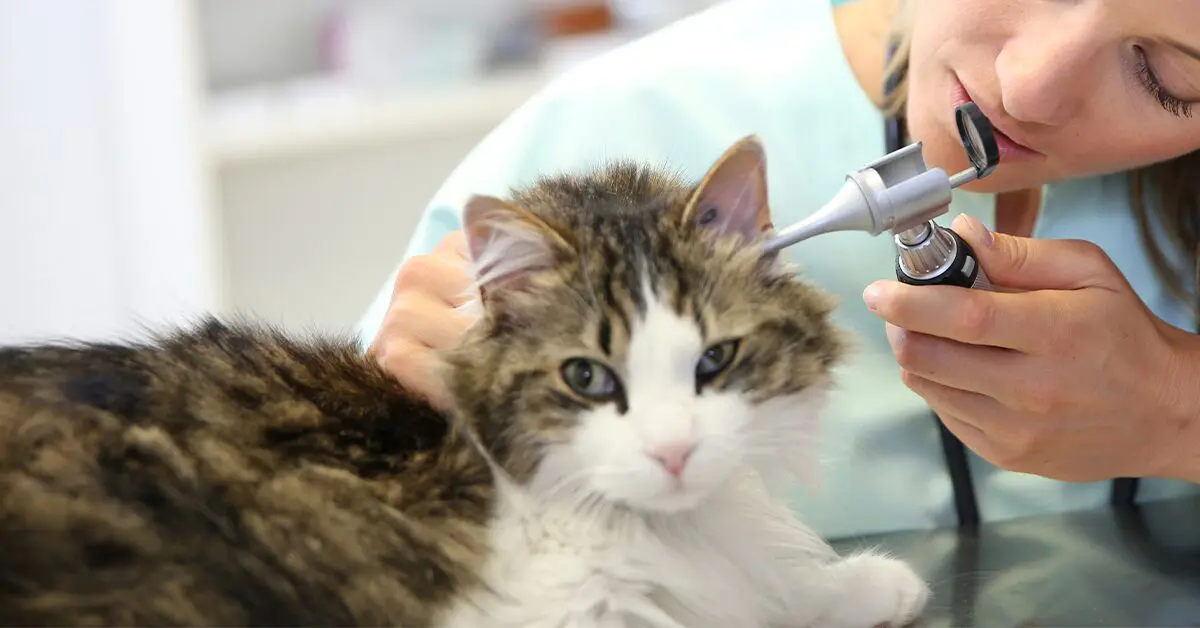What does an ear infection in cats look like?
Ear infections in cats cause pain, discomfort, and in severe cases, problems with balance and hearing loss. The symptoms can occur suddenly or gradually, and last for long periods of time. Many cats will shake their head and scratch their ears trying to fix the pain or irritation, but often, cause more harm as their ears become red and inflamed.
Ear infections in cats are categorized by the part of the ear that’s affected:
- Otitis Externa, or outer ear infection, is when the outer portion of the ear and the pinnae (ear flap) becomes infected.
- Otitis Media, or middle ear infection, is when the middle part of the ear becomes infected.
- Otitis Interna, or inner ear infection, is when the inner ear becomes infected.
While cats don’t often get ear infections, they are painful and will likely not go away on their own. It’s important to familiarize yourself with signs and indicators of this type of condition so that you can get your feline friend help if they need it.
Are ear infections common for cats?
Although cat ear infections aren’t common, they’re certainly not unheard of. Ear infections can happen to cats of any age or breed, but cats with allergies, diabetes, or conditions that weaken the immune system may be more at risk. Breeds with small outer ears, like Himalayans and Persians as well as outdoor cats and kittens are more prone to ear infections. However, even older, indoor cats aren’t immune.
If unchecked, two potential long-term complications of Otitis Interna include a permanent loss of balance (signs might include missing easy jumps or staggering when they walk) and/or persistent signs of Horner’s syndrome. Horner’s syndrome is a combination of signs and symptoms caused by the disruption of a nerve pathway from the brain to the face and eye on one side of the body. Signs of Horner’s syndrome include a drooping eyelid, protruding third eyelid, and a pinpoint pupil.
While this is rare, a severe inner ear infection can spread to parts of a cat’s brain that control their breathing and heart rate. In worst cases, a cat may suffer hearing loss in the affected ear if the infection isn’t treated properly. If your cat appears to be ignoring you, take note.
How do cats get ear infections?
In most cases, bacterial or fungal ear infections in cats are caused by underlying skin allergies to environmental allergens like pollen or mold, or food allergies. In some cases, moisture in the ear usually from a bath can cause a bacterial or fungal ear infection.
Ear mites are a very common cause of ear infections in cats. Ear mites are microscopic bugs that are highly contagious in cats and live in the ear. Ear mites cause itchiness, inflammation, and constant scratching that often progresses into a bacterial or fungal ear infection. Ear mites spread via direct contact between cats, and are most commonly found in young kittens, outdoor cats, and cats living in shelters or other crowded environments.
Tumors, polyps, and allergies can also cause chronic inflammation and discomfort, which can lead your cat to profusely scratch their ear and cause trauma. Fungal infections like ringworm can also lead to infection and changes in the ear’s appearance, but this is normally limited to the ear tip margins rather than the ear canal itself.
Are ear infections in cats contagious?
Bacterial and fungal ear infections are not contagious, but ear mites are very contagious. If one cat in your household is affected by ear mites, talk to your veterinarian about preventative treatment measures for your other feline friends.
What are the symptoms of ear infections in cats?
Ear infections can affect one or both of your kitty’s ears, and you may even see changes in their demeanor. Signs of an ear infection vary depending on the cause and location of the infection, but cats suffering generally exhibit:
- Strong odor around the ears
- White specks that may be moving – these are mites
- Redness around the ear, which indicates inflammation
- Discharge from the ears of any color
- Excess wax buildup
- Head-shaking or head-tilting
- Pawing at the ears
- Rubbing the ear on the floor or furniture
- Scaly skin
- Scabbing and other signs of self trauma from scratching
How are ear infections in cats diagnosed?
By examining your cat’s ear and looking out for the symptoms above, you can identify early signs of an ear infection. However, your vet should perform an in-depth physical examination to identify the root cause. Diagnosis of an ear infection begins when your veterinarian swabs your cat’s ear and looks at it under a microscope to determine the exact cause of infection: mites, yeast (fungus), or bacteria. Evidence of scratching at or around the ears can indicate discomfort, while a peek inside your cat’s ear with an otoscope can reveal abnormalities, debris, tumors, or polyps.
While it’s essential your vet gets a good look inside your cat’s ears to accurately diagnose the infection, painful ears can cause your cat to be uncooperative during the vet visit. Depending on their age and comfortability, your cat may require sedation for all or part of the examination.
How are ear infections in cats treated?
How your cat’s ear infection is treated will depend on the cause of the infection, but they’re usually treated with antibiotics or anti-fungal medications. If your cat has ear mites, these are also treated with medication. Typically, the vet will prescribe a topical medication to rub onto your cat’s ear, coating the top layer of the external ear canal with a thin film. The vet may gently clean your cat’s ears first to ensure the topical medication is effective, depending on the amount of discharge and buildup that’s in your cat’s ear.
In the case of severe inflammation that narrows the ear canal, a perforated or ruptured ear drum, or middle or inner ear involvement, oral or injectable antibiotics may be necessary. In severe cases that can’t be treated by medication, surgery may be needed to excise the infection. While cats will experience some hearing loss from this procedure, they can still hear through their head, everything just sounds muffled.
For healthy ears, it’s important to follow your vet’s instructions closely and give your cat their prescribed medications. If not treated properly, the infection could come back.
How much does it cost to treat ear infections in cats?
The cost for treating ear infections in cats depends on the cause of the infection and veterinary practice. The cost usually includes the exam fee, diagnostics, medications, and (if necessary) any follow-up examinations. If your cat requires sedation, anesthesia, or surgery, this will add considerably to your bill. Most uncomplicated ear infections due to ear mites can be treated for under $100.
What is the prognosis of ear infections in cats? Are they curable?
Yes, ear infections in cats are curable. Medical management will resolve the infection in most cases unless your cat suffers from chronic ear infections caused by underlying medical issues such as allergies. In these cases, treating the allergy usually eliminates recurrent ear infections.
How can I help prevent my cat from getting an ear infection?
Cats generally don’t require regular ear cleanings, but you should still make it a habit to check your cat’s ears for irregularities on a regular basis, and watch your cat for any signs of ear infections. This way, you can spot any potential problems before they get out of hand. There is no vaccine for ear infections in cats.
How can pet insurance help?
If you’re a cat owner and suspect your four-legged friend has an ear infection, you should schedule an appointment for a physical exam with your vet immediately. If your cat gets hurt or sick, pet insurance can help you say ‘yes’ to the best care, even when it’s costly. Check out how Pumpkin cat insurance plans can help cover the cost of an ear infection and keep your cat healthy for life.
Looking for more resources on ear infections in cats?
Check out these sites:




